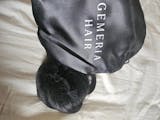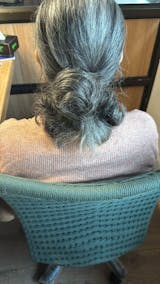Wigs are a great way to instantly alter how you look by changing your natural hair. Finding the right fit is important when testing out a new style, hiding hair loss, or simply playing with different lengths and colors. A poorly fitting wig may shift, feel uneasy, or look weird, which defeats the purpose of having one in the first place.
Knowing how to correctly measure your head for a wig is important to having a smooth, comfortable wig journey. Often people make the mistake of guessing their size or assuming that one size fits all, which frequently ends in disappointment. In our comprehensive wig size guide, we'll walk you through the simple process of measuring your head to make sure you get the correct wig size, which feels perfect on you.
According to Simply Wigs research, around 70 percent of wig returns are because of wrong sizing; making the right measurement is how you get the best wig. This blog is your best resource to help you figure out how to measure my head for a wig once and for all. You will get the right wig with this quick read.
What You Need Before You Start
Before you start measuring for wig sizes, you need some things:
- A measuring tape, preferably a flexible one.
- A Mirror (If it’s full-length, that will be good)
- A paper and pen for writing down your measurements.
- A friend to help you.
If you can’t find a flexible measuring tape, you can use a string and simply measure that string length on a ruler. Do make sure that your hair is styled as if you have to wear a wig, like pulled back tightly or wearing a wig cap. This actually helps you to find the right head size rather than just volume of hair.
It is also helpful to know that your head size changes a little bit throughout the day because of natural swelling. For the perfect results, measure in the evening time, when it’s at the largest. This prevents a wig that fits perfectly in the morning from being extremely tight during the afternoon or evenings.
Understanding Wig Cap Sizes
Wig manufacturers generally provide three standard sizes: large, medium/average, and small. Some brands do provide custom sizes as well. According to the data, these sizes do correspond to the following circumferences:
-
Large: 23 to 23.5 inches.
-
Average to Medium: 21.5 to 22.5 inches.
-
Small: 20.5 to 21 inches.
However, these ranges can change greatly between manufacturers, which is why obtaining your measurements is critical. According to research, about 90% of customers have an average/medium size, but it is always best to measure before you guess.
Most ready-to-wear wigs include adjustable straps that allow for 1 inch of adjustment in both directions, but starting with the ideal base size provides the best comfort and a natural appearance. Understanding wig sizes is essential since a small wig will cause pressure points and headaches, while a big wig can move around and look odd.
How to Measure Your Head—Step-by-Step
This is how to measure wig cap size in a step-by-step manner to get the correct wig size:
1. Measure around your hairline: forehead, ears, and nape
This is one of the most important measurements that determines wig cap measurements.
- Place the measuring tape at your hairline for the forehead.
- Bring that around your head, just passing for it, passing for it for years (and not behind them).
- Continue for the nape of your neck (that bony protrusion at the base of your skull).
- Bring that tape back for your starting point for your forehead. Place the tape measure for your natural hairline.
2. Measure from the front hairline (mid-forehead) over the crown to the nape.
- Begin close to the center of your forehead, where the hairline is thinnest.
- Bring the tape measure over the crown of your head (the highest point) from there to the nape of your neck.
- It helps decide how the wig will sit properly from front to back. If this length is too long, the wig could swell in the back; if it is short enough, it will sit uncomfortably on the forehead.
3. From the top of one ear to the top of the other, across the forehead
- Placement of the tape measure for the ear: follow the hairline for your forehead for the top of your hair.
- This type of measurement ensures that wigs won't directly sit correctly from front to back.
- A common mistake is towards measuring the top of the ear, which causes the wig to fit too tightly on the ear, making it uncomfortable.
4. From the top of one ear to the top of the other over the crown of your head
- Begin close to the center of your forehead and where your hairline is thinnest. Bring the tape measure over the crown of your head (the highest point) down to the nape of your neck.
- It helps determine how the wig will fit smoothly from front to back. If this dimension is too long, the wig could swell in the back; if it is too short, it will hang uncomfortably on the forehead.
5. Measure across the nape (the back bottom part of your neck).
- Placing the data measure with the bottom of your along with tracing along with the hairline as in at the nape.
- This ensures that the wig fits perfectly flush with your head and does not bulge.
- This measurement is important for those that have pronounced occipital bones and generally struggle with wigs lifting from the backside.
Tips for Accurate Measuring
To get the best wig cap measurements, remember to take in these steps for the perfect wig sizes:
- This is essential when deciding how to correctly calculate wig cap size.
- The consistency of measurement encourages precision.
- Check that it fits properly but not tight enough that it creates discomfort or pressure, your finger should be able to move effortlessly under it.
- If you have thick or curly hair, flatten these as much as possible or simply wear a wig cap for measurement of true head size.
- Do ask a friend for help, it is difficult to hold the tape by yourself while looking at the mirror and having the right alignment.
- Pay extra care to the tightest-fitting place to avoid tension spots that can cause headaches.
- Take measures at the end of the day, when the head is slightly bigger due to normal swelling, for maximum comfort.
- Consult a wig measurement chart from the brand you like to double-check your measurements, as size varies substantially between manufacturers.
- For those who have very thick hair, try measuring both with and without a wig cap to see what works best for you and gives the most natural fit.
Also Read: Choosing the Perfect Full Head Human Hair Wig
What to Do If You're Between Sizes
It’s completely normal to find yourself directly stranded between different wig sizes. Here’s exactly what you can do if you’re stuck between sizes. These are the steps to follow:
- When in uncertainty, go for the larger size for comfort, because you can always tighten it, but a wig can't be made big.
- Look for wigs for women that have multiple adjustment options (elastic, Velcro, or hook straps) for perfect customization.
- Elastic straps stretch by pushing to add tension, Velcro adapts by sliding toward the center, and hooked straps have numerous slots for incremental sizing.
- Look into using wig grips or silicone strips in order to hold a slightly loose wig without affecting your scalp. For frequent fitting issues, try custom wig decisions that fit precisely to your specific size.
Conclusion
Taking the effort to properly measure your head for a wig makes an important difference in comfort, appearance, and confidence. With the right measurements, you can quickly select the wig sizes that stay securely in place, remain comfortable all day, and look completely natural.
Remember that employing this wig size chart will make it easy to get your perfect fit. Understanding your head's dimensions and examining your preferred brand's wig measuring guide can help you escape the main dangers of not fitting wigs.
Whether you are just new to wigs or already know about and use wigs, this wig size guide is for the seasoned wearer and accurate measurements and also ensures most of the adjustments. Now you know how to measure wig cap size through this blog; you can easily get the right wig.
When searching for your next wig, have the following size guide ready, and don't be afraid to speak with wig experts who can explain your dimensions. After all, the perfect fit is what separates a wig that feels like an accessory and one that feels like a part of you. With the right sizes, you can get the simple, natural look that makes people ask, "Is that really a wig?"













